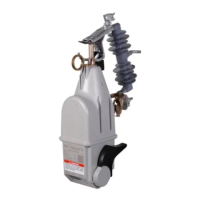64 S&C Instruction Sheet 461-504
Informational and Settings Screens
For Definite Time
If the DeniteTime setting is selected from the same Inverse Segment selection
menu, additional elds will open, described below. See Figure 89. Note: When the
DeniteTime setting is selected, the test operation can be copied to the clipboard or
saved to a setpoint le.
Figure 89. The additional fields when DefiniteTime is selected under Inverse Segment.
Figure 90. The DefiniteTime Reset Time setting field for E/M Reset Type.
Current, A. Specify the current (in primary amperes) at which the DeniteTime setting
begins timing (minimum value: 5; maximum value: 400). This eld is mandatory.
Time, s. Specify the time delay (in seconds) after which the DeniteTime setting trips
(minimum value: 0; maximum value: 1,000). This eld is mandatory.
Reset Type. Select the reset method for the DeniteTime setting from the drop-down
list: “D/T” (Denite Time) or “E/M” (Electromechanical). (This not to be confused with
the O/C Sequence Time setting. “Reset” here means how fast that curve will reset if it
has picked up but fault disappears before the TripSaver II recloser could trip.) This eld
is mandatory.
Reset Time, s. Specify the time delay (in seconds) before DeniteTime setting resets
under “D/T reset type” (minimum value: 0; maximum value: 1,000). This eld is mandatory.
Reset Time, s (I0A). When the Reset Type setting is “E/M”, the title of the Reset
Time eld will be changed to “Reset Time, s (I0A)”. The value specied here is the time
delay (in seconds) before the DeniteTime element resets when load current owing
is at 0 A (minimum value: 0; maximum value: 1,000). The actual reset time used by the
electromechanical reset will be calculated using the following quadratic algorithm: the
value in this eld/(the load current / the current entered)^2 - 1). This eld is mandatory.
See Figure 90.

